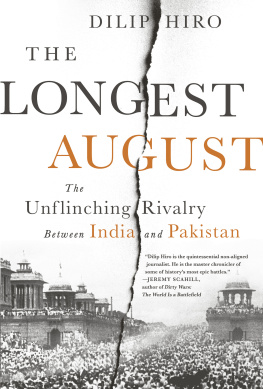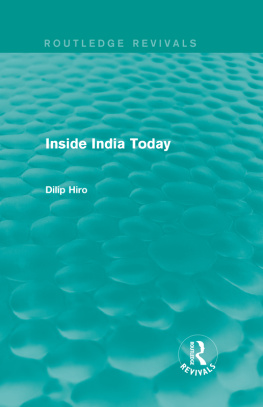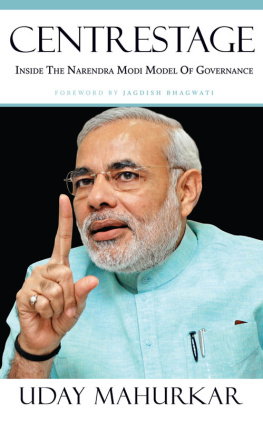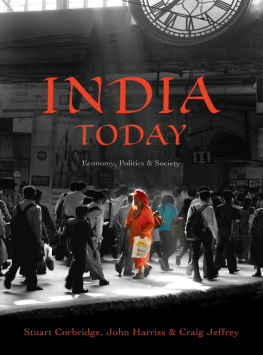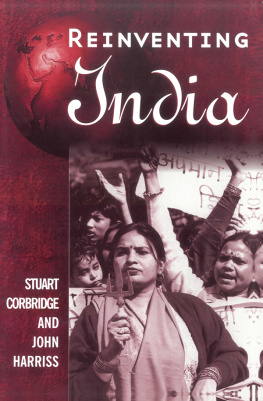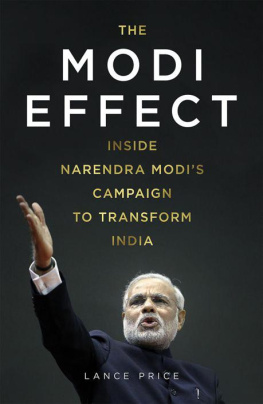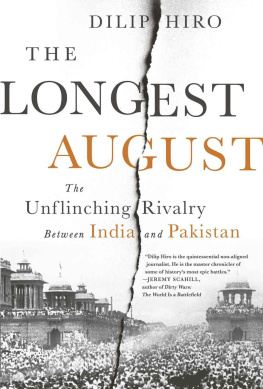The Age of Aspiration
ALSO BY DILIP HIRO
Nonfiction
The Longest August: The Unflinching Rivalry Between India and Pakistan (2015)
A Comprehensive Dictionary of the Middle East (2013)
Apocalyptic Realm: Jihadists in South Asia (2012)
After Empire: The Birth of a Multipolar World (2010)
Inside Central Asia: A Political and Cultural History of Uzbekistan, Turkmenistan, Kazakhstan, Kyrgyzstan, Tajikistan, Turkey, and Iran (2009)
Blood of the Earth: The Battle for the Worlds Vanishing Oil Resources (2007)
The Timeline History of India (2006)
The Iranian Labyrinth: Journeys Through Theocratic Iran and Its Furies (2005)
Secrets and Lies: Operation Iraqi Freedom and After (2004)
The Essential Middle East: A Comprehensive Guide (2003)
Iraq: In the Eye of the Storm (2003)
War Without End: The Rise of Islamist Terrorism and Global Response (2002)
The Rough Guide History of India (2002)
Neighbors, Not Friends: Iraq and Iran After the Gulf Wars (2001)
Sharing the Promised Land: A Tale of Israelis and Palestinians (1999)
Dictionary of the Middle East (1996)
The Middle East (1996)
Between Marx and Muhammad: The Changing Face of Central Asia (1995)
Lebanon: Fire and EmbersA History of the Lebanese Civil War (1993)
Desert Shield to Desert Storm: The Second Gulf War (1992)
Black British, White British: A History of Race Relations in Britain (1991)
The Longest War: The Iran-Iraq Military Conflict (1991)
Holy Wars: The Rise of Islamic Fundamentalism (1989, reissued 2013)
Iran: The Revolution Within (1988)
Iran Under the Ayatollahs (1985, reissued 2011)
Inside the Middle East (1982, reissued 2013)
Inside India Today (1977, reissued 2013)
The Untouchables of India (1975)
Black British, White British (1973)
The Indian Family in Britain (1969)
Fiction
Three Plays (1985)
Interior, Exchange, Exterior (1980)
Apply, Apply, No Reply & A Clean Break (1978)
To Anchor a Cloud (1972)
A Triangular View (1969)

2014, 2015 by Dilip Hiro
All rights reserved.
No part of this book may be reproduced, in any form, without written permission from the publisher.
Requests for permission to reproduce selections from this book should be mailed to:
Permissions Department, The New Press, 120 Wall Street, 31st floor, New York, NY 10005.
First published in India as Indians in a Globalizing World by
HarperCollins Publishers India, Noida, 2014
This revised edition published in the United States by The New Press, New York, 2015
Distributed by Perseus Distribution
LIBRARY OF CONGRESS CATALOGING-IN-PUBLICATION DATA
Hiro, Dilip.
[Indians in a globalizing world]
The age of aspiration: power, wealth, and conflict in globalizing India / Dilip Hiro.
pages cm
First published in India as Indians in a globalizing world, by HarperCollins Publishers India, Noida, 2014Title page verso.
Includes bibliographical references and index.
ISBN 978-1-62097-141-3 (e-book)
1. IndiaEconomic policy1991 2. IndiaSocial conditions1947 3. GlobalizationSocial aspectsIndia. 4. Social changeIndia. 5. Power (Social sciences)India. 6. WealthSocial aspectsIndia. 7. Political cultureIndia. 8. Social conflictIndia. 9. East IndiansGreat Britain. 10. East IndiansCalifornia. I. Title.
HC435.3.H57 2015
330.954dc23
2015013943
The New Press publishes books that promote and enrich public discussion and understanding of the issues vital to our democracy and to a more equitable world. These books are made possible by the enthusiasm of our readers; the support of a committed group of donors, large and small; the collaboration of our many partners in the independent media and the not-for-profit sector; booksellers, who often hand-sell New Press books; librarians; and above all by our authors.
www.thenewpress.com
Composition by Westchester Book Composition
This book was set in Adobe Caslon
2 4 6 8 10 9 7 5 3 1
Contents
Map 1: India

Map 2: Main Area of Maoist Influence

Map 3: Silicon Valley, Northern California (USA)

Map 4: United Kingdom

It is hard to challenge Fortune magazines recent claim that globalization has been the world economys central storylinehas penetrated and transmuted the lives of hundreds of millions of Indians at home as well as abroad, particularly in the United States and Britain. It has created new wealth in India, boosting economic expansion, and it has fostered a powerful consumerist culture.
The dramatic transformation is aptly captured in the role reversal of the heroes of Indian cinema (known worldwide as Bollywood) over the past decades. Bollywood is a staple of mass entertainment and, as such, reflects and reinforces the nations concerns, aspirations, and values. The movie Guru, inspired by the life of the late industrial magnate Dhirubhai Ambani, father of Indias current topmost billionaires, Mukesh and Anil Ambani, was a smash hit in 2007. In it, Gurukant Guru Desai, played by Abhishek Bachchan, is portrayed as a ruthless, lawbreaking businessman who overcomes the economic hurdles created by the state, moored in central planning, to become a towering business magnate. This relentlessly pro-capitalist film presents Gurukant as a visionary, a harbinger of popular private enterprise as it is raucously lauded in todays media. Produced at the cost of Rs 150 million ($3 million), Guru saw a box-office gross of Rs 812 million ($16.2 million), collected at the new multiplexes that have sprouted up across India to cater to the expanding middle class as well as the affluent Indian diaspora.
By happenstance, the sea change is reflected in the roles played by the Bachchan family. Abhisheks father, Amitabh, became a popular larger-than-life angry young man in the 1970s thanks to his roles as a hero from a poor background in such films as Deewar (Wall) and Sholay (Flames). The affluent in those films were either unscrupulous businessmen or exploiting landlords.
The first signs of change appeared in the 1990s. As the scholar Vamsee Juluri observes in his book Bollywood Nation: India Through Its Cinema, the movies of this period held aloft the family as the ideal symbol of morality through the wedding as the ultimate expression of consumer power, but beyond that they forgot all about angry young men and toiling peasants. More recently, a crop of multiplex movies has appeared. An abiding feature of these films is the flaunting of a characters net worth in cash, Juluri observesa sharp contrast from the movies of yesteryear, when affluence was suggested by a palatial house or an imported car. The new leitmotif is in tune with the clientele of the multiplexes, whether the cinemas are independent or housed in glitzy shopping malls. The admission price itself excludes working-class patrons, to the smug satisfaction of the prospering customers.
Next page


